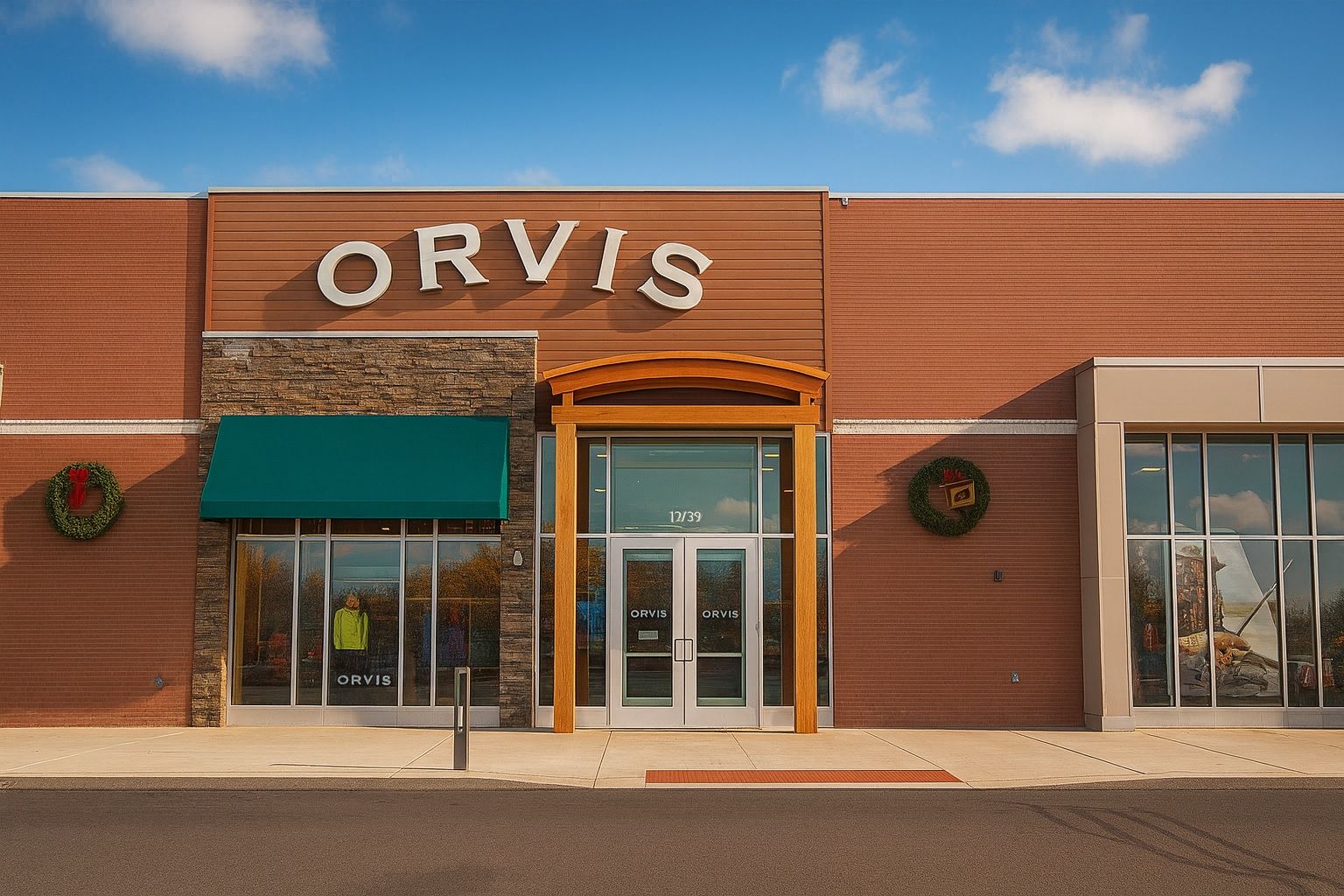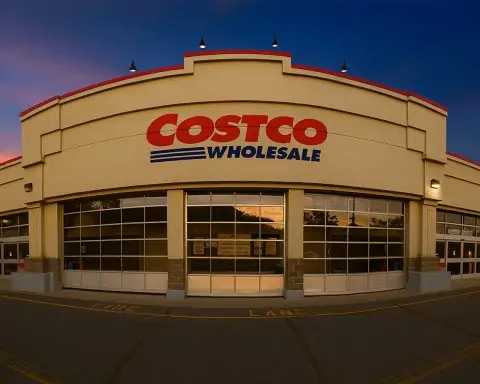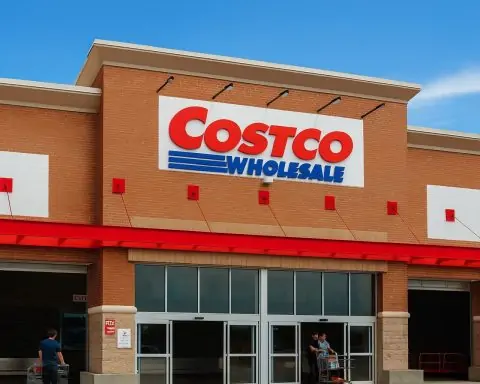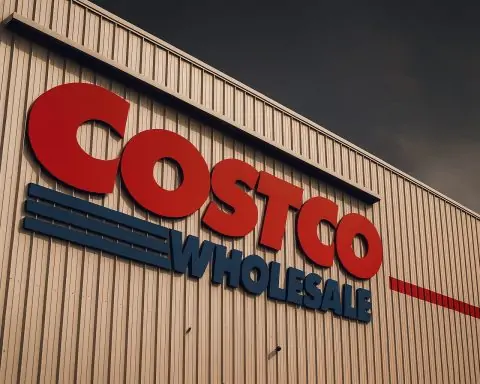- Heritage retailer closing half its stores: Iconic outdoor outfitter Orvis – founded in 1856 – will shutter 36 of its retail locations (31 full-price stores and 5 outlets) by early 2026, roughly half of its current footprint [1]. The downsizing will leave Orvis with 33 stores and just 2 outlets nationwide [2]. The company has not yet disclosed which stores will close, but Orvis presently operates about 71 locations across the U.S. [3] [4].
- Tariffs blamed for drastic cuts: Orvis’ leadership cites an “unprecedented tariff landscape” under the Trump administration as a major factor forcing these reductions [5]. President Simon Perkins said steep import duties have “disrupted our business model in ways we haven’t faced before” [6]. In April 2025, a new round of U.S. tariffs imposed an across-the-board 10% hike (with some rates up to 50%), raising Orvis’s costs by an average 16% on all imports [7]. Perkins acknowledged the company “had to be bold” in response, opting to rescale by tightening its assortment and shrinking its store footprint to survive [8].
- Refocusing on core business: The venerable retailer is “returning to our roots,” doubling down on its heritage fly-fishing and wingshooting (bird hunting) niche [9]. Orvis plans to phase out peripheral “lifestyle” product lines – such as high-end apparel, home goods and other non-sporting merchandise – that critics say had “nothing to do with the outdoors” [10]. Going forward, the company will concentrate on what it does best: fly rods, fishing gear, hunting equipment, guided outdoor experiences, and conservation initiatives [11] [12].
- Leveraging dealers and online channels: With fewer company-owned stores, Orvis will lean on its extensive wholesale and online presence. The brand already sells through over 550 independent dealers (local fly shops, sporting goods stores) and several national partners like Bass Pro Shops, Cabela’s, and Sportsman’s Warehouse [13]. Perkins emphasizes that Orvis stores will remain “an essential component” of its strategy, but customers can increasingly access Orvis gear “in person, online, or through our valued local partners,” including its direct e-commerce site and Orvis Adventures travel services [14] [15].
- Year of layoffs and restructuring: The store closures cap a tumultuous period for Orvis. In late 2024, the company laid off 112 employees (8% of staff) and discontinued its famous mail-order catalog after 167 years, pivoting fully to digital retail [16]. Mid-2025 saw another 50 layoffs (4% cut) as tariffs squeezed margins [17]. Orvis even put its sprawling 351-acre Vermont headquarters up for sale (listed at $5.85 million) to consolidate operations and cut costs [18]. The privately held company – owned by the Perkins family since 1965 – has been paring down to “a smaller and more agile business” to ensure it can endure for decades to come [19] [20].
- Retail headwinds across the sector: Orvis’s struggles reflect broader retail industry challenges in 2025. U.S. retailers announced nearly 76,000 job cuts in the first five months of 2025 – a 274% surge from a year earlier – as chains from Joann Fabrics to Rite Aid shuttered stores en masse [21]. Companies reliant on imported goods have been especially hard-hit by tariffs. Even giants like Macy’s revealed they faced import duties up to 145% on certain products [22]. Many retailers have responded by closing underperforming stores (fueling that spike in layoffs) or hiking consumer prices to offset rising costs [23]. The tariff war has “injected volatility across sectors”, forcing firms from auto-makers to apparel sellers to slash profit forecasts [24].
- Outlook – cautious optimism: Analysts say Orvis’s drastic reboot is a bid to save an outdoor retail icon by shedding weight and playing to its strengths. By focusing on its loyal fly-fishing and hunting customer base – and offloading pricey store leases and slow-selling product lines – Orvis aims to stabilize its finances and protect its brand heritage [25] [26]. The company insists popular offerings like its fly-fishing classes, guided trips, and legendary warranty service will remain unchanged as it refocuses [27] [28]. However, success is not guaranteed. If trade pressures or consumer trends worsen, Orvis’s smaller footprint could limit its reach. (Notably, Sportsman’s Warehouse, a publicly traded outdoor gear retailer, has seen its stock languish around $3 per share in recent days [29] – reflecting investor skepticism toward the sector’s growth prospects.) On the other hand, any relief in the trade war – the U.S. Supreme Court has fast-tracked a review of the Trump-era tariffs [30] – or a resurgence in outdoor recreation spending could give Orvis a much-needed boost. For now, the 169-year-old company is betting that getting “leaner” and “sharpening our focus” will ensure it can continue to serve anglers and adventurers for the next century [31] [32].
An Iconic Outfitter Scales Down
Founded in 1856, Orvis is among America’s oldest outdoor retailers – a name synonymous with fly fishing rods, tackle, and rustic New England sporting tradition. Over nearly 170 years, the family-run company grew from a small Vermont tackle shop into a national premium brand with dozens of stores selling not just fishing gear and hunting shotguns, but apparel, home furnishings, dog beds, luggage, and more. By the mid-2010s, Orvis operated around 80 stores and had a thriving catalog business mailing out millions of catalogs annually.
But in recent years, the retailer’s footprint and focus have been shrinking. On October 10, 2025, Orvis confirmed it will permanently close 36 retail locations by early 2026 [33]. That includes 31 of its full-line stores and 5 outlet stores, leaving roughly 35 locations going forward – barely half of what it operates today [34]. For many longtime Orvis patrons, the news is jarring: some towns will lose their local Orvis store that has been a fixture for years. Orvis has not released a list of which stores are slated to shutter, creating uncertainty in communities from San Francisco to Boston where Orvis has a presence. A quick scan of Orvis’s website shows at least 64 retail stores and 5 outlets currently open [35] – all part of the venerable retailer’s carefully cultivated network of brick-and-mortar outposts.
Simon Perkins, Orvis’s president, acknowledged the gravity of the decision but framed it as a necessary step for the company’s survival. “We are focusing on our core strengths and making the difficult but necessary decision to rescale the business by…reducing our corporate store footprint,” Perkins said in a statement announcing the closures [36]. After nearly two centuries in business, Orvis is effectively pulling back to the stronger half of its store fleet and abandoning the rest. The closures are scheduled to be completed “early next year,” i.e. by the first quarter of 2026 [37].
For remaining Orvis stores, the company is already preparing clearance sales and special promotions. Perkins noted that as part of this transition, shoppers will see “substantial savings at closing store locations,” and “Last Release” deals on discontinued items that “will not return once they are gone.” [38] In other words, as Orvis prunes its product assortment (more on that below), it will offer deep discounts to sell through the excess inventory – a bittersweet perk for fans of the brand in areas where stores are closing.
Tariffs and Economic Turbulence Spark Cuts
Why is Orvis dramatically downsizing now? In a word: tariffs. The company has pointed to the U.S.–China trade war and its fallout as a primary driver of its financial strain. “Like many in retail, Orvis’ business model faced a sizeable shift with the introduction of an unprecedented tariff landscape,” Perkins explained, referring to the waves of import tariffs instituted under President Donald Trump [39]. These tariffs – essentially taxes on goods imported from overseas, especially from China – have raised costs for American retailers across the board. Orvis sources a significant share of its merchandise (like clothing, dog beds, gift items, and even some fishing gear components) from abroad, so it has been directly exposed to those higher import costs.
In fact, 2025 brought a fresh onslaught of tariffs. In April, the Trump administration (re-elected, and continuing its protectionist trade policy) implemented a universal 10% hike on U.S. import duties, with certain countries and products seeing tariff rates jump as high as 50% [40]. The average U.S. import duty rose by about 16% virtually overnight [41]. For a retailer like Orvis, which cannot instantly shift all sourcing to domestic factories, this was a crushing blow. Perkins stated plainly that “tariffs have disrupted our business model in ways we haven’t faced before” [42], creating cost pressures that the company struggled to absorb.
Orvis is far from alone. Retailers nationwide have been reeling from the escalating trade war. Chains that sell imported apparel, footwear, electronics, or furniture have faced either squeezed profit margins or tough choices: raise prices for shoppers (and risk losing sales) or eat the higher costs and watch earnings plummet. Many have done both, with mixed results. “Orvis [is] one of a number of domestic retailers stung by the new tariffs,” industry journal CoStar News noted, as companies scrambled to find alternative sourcing or cut expenses [43]. Some retailers have explicitly blamed tariffs for store closures and layoffs, while others have quietly passed on costs to consumers [44]. Even retail titans haven’t been spared: department store Macy’s, for example, revealed it was hit with import duties as exorbitant as 145% on certain merchandise, underscoring how extreme the tariff impact can be [45].
For Orvis – a mid-sized, family-owned company – the tariff bills proved unsustainable without a major course correction. The company already had relatively premium prices for its gear and apparel; simply marking everything up further to offset tariffs wasn’t a realistic long-term strategy, since customers might flee to competitors. Instead, Orvis determined it had to slash operating costs to align with a new higher-cost reality for goods. That meant shrinking the workforce, closing stores, and eliminating less profitable product lines.
Indeed, Perkins described the decision to halve the store count as part of “solidifying our long-term future” amid external pressures [46]. By focusing on fewer stores and a tighter inventory mix, Orvis hopes to weather the tariff storm and remain profitable. The president’s statement cast the moves as positioning Orvis to “ensure a durable brand and model for decades to come” despite the challenging environment [47].
It’s worth noting that trade policies are still in flux. In a surprising development, the U.S. Supreme Court signaled it will weigh in on the legality of Trump’s sweeping tariffs, granting an unusually fast-tracked hearing on the issue [48]. The case (brought by business groups arguing the tariffs were an overreach of executive power) is expected to be heard in the coming term. Any court decision or negotiated trade deal that rolls back these duties could relieve some pressure on import-reliant retailers. But Orvis cannot bet its future on uncertain political outcomes; the company is acting now to cut costs, assuming the current tariff regime persists. “To ensure [we endure] for decades to come, we are focusing on our core strengths and making the difficult but necessary decision to rescale,” Perkins said [49] – a clear message that Orvis is battening down the hatches to ride out a long storm.
Beyond tariffs, other economic headwinds have buffeted outdoor retailers like Orvis. The COVID-19 pandemic gave a temporary boost to outdoor recreation spending (as stir-crazy consumers took up fishing, hiking and camping), but that surge leveled off. Meanwhile, the industry has faced what one Outside magazine report called a “laundry list of hurdles” – from climate change and extreme weather disrupting outdoor activities, to lingering supply-chain aftershocks from COVID, to rising inflation hitting consumers’ wallets [50]. Even competition from “indoor” leisure pursuits (think video games and streaming entertainment) has made it harder for outdoor brands to win customers [51]. Add new tariffs to the mix, and several of these problems get even more challenging [52], as a former Orvis executive wrote in MidCurrent.
All told, the outdoor retail sector in 2025 is under intense pressure. Many companies expanded during good times and are now contracting. For example, Patagonia and REI, two of the biggest names in outdoor gear, have admitted to revenue struggles in recent years and implemented staff reductions of their own [53]. The pain is even more acute for smaller specialty brands. Trade groups note that tariff hikes tend to hit small and mid-sized businesses hardest, since they have less leverage with suppliers and thinner margins to begin with [54]. “Tariff hikes have historically been most devastating to small businesses… But medium and large-sized businesses like Orvis are also reeling from the effects,” GearJunkie reported, underscoring that even an established company of Orvis’s size is struggling to thrive amid the trade war’s fallout [55].
Back to Basics: Fly Fishing, Hunting and “Protecting What We Love”
Faced with these challenges, Orvis is executing a strategic retreat to what made it famous in the first place: fly fishing and upland hunting. “Since 1856, Orvis has inspired generations of adventure in the field and on the water,” Simon Perkins wrote in his public remarks. “Guided by that same purpose, we are entering an exciting new chapter by returning to our roots and sharpening our focus on the pursuits at the heart of our heritage: fly fishing and wingshooting.” [56] In practice, this means Orvis will put nearly all its energy into designing and selling top-quality fishing rods, reels, lines, and tackle; performance outdoor apparel and gear for anglers and hunters; guided trips and experiences (through Orvis Adventures and its network of endorsed lodges and outfitters); and supporting conservation causes that align with these pursuits.
Orvis’s recommitment to core outdoorsmanship also means saying goodbye to some of the product categories it ventured into over the past few decades. As the company grew, it had branched out into upscale casual clothing (for example, blazers, dresses and fashion accessories marketed to non-anglers), home furnishings and decor (like furniture, bedding, and even whimsical items like Orvis doormats), luxury travel gadgets, and gifts. These moves were aimed at broadening Orvis’s appeal beyond the hardcore fly fisher, turning it into a more diverse “lifestyle” brand. However, many traditionalists felt Orvis was losing its identity. According to MidCurrent, “the angling community [gave Orvis] plenty of heat for its more ‘lifestyle’ products that have nothing to do with the outdoors, such as women’s fashion, home goods, and an infamous $1000 leather cooler.” [57] Perkins has essentially acknowledged this criticism. Those extraneous product lines are “the kind of stuff that’s going away” as Orvis leans back into what it truly knows – fishing and hunting gear [58].
Importantly, Orvis is not exiting the apparel business entirely, nor is it abandoning the idea that its wares can be stylish. Rather, it will concentrate on functional clothing “aligned with the core” – think high-performance fishing waders, upland hunting jackets, field pants, and country lifestyle apparel that directly ties into outdoor sport. A company spokesperson told CoStar that Orvis “is not fully exiting lifestyle apparel” despite the changes [59]. So customers will likely still see Orvis-branded sweaters and khakis, but those items will be curated to fit an angler’s or shooter’s wardrobe, instead of chasing every fashion trend. By tightening its assortment, Orvis can reduce complexity and costs. Perkins noted that with a leaner operation, “we’re going to be able to…focus all of [our processes] on our core business, which is exciting.” [60] Freed from managing too many disparate categories, Orvis’s product development teams can zero in on innovating the next-generation fly rod or improving wader design, rather than, say, sourcing home decor items.
In his statement, Perkins was keen to highlight that this refocusing is about more than products. “This focus is about ensuring Orvis continues to lead in innovation, serve our angling and upland communities, and protect the wild places we love,” he said [61]. That ethos speaks to Orvis’s longstanding brand values – the company has long prided itself on environmental conservation efforts (donating 5% of pre-tax profits to conservation causes) and on being a hub for the fly-fishing community. Those elements are here to stay or even grow. “Looking ahead, we are investing in the areas where Orvis makes its greatest impact – world-class gear and apparel, unforgettable experiences, and a deep commitment to conservation,” Perkins affirmed [62]. In concrete terms, expect Orvis to put more resources into things like its endorsed lodges and guides program, its Orvis Adventures travel offerings, conservation grants, and the educational content (like how-to videos, podcasts, and schools) that help nurture new outdoor enthusiasts. All of these initiatives bolster Orvis’s core mission of inspiring adventure in nature – which, not coincidentally, also helps drive sales of its gear.
Customers, Dealers, and the New Orvis Experience
What will these changes mean for Orvis customers? In the near term, shoppers in certain areas will unfortunately see their local Orvis store close its doors. The company did not publicly list which 36 locations are on the chopping block. However, some retail analysts speculate that Orvis will likely shutter stores in higher-cost urban markets or underperforming locations where sales have lagged. For example, Orvis closed its Fifth Avenue New York City store a few years ago, and could now pull out of other metro areas where rent is high and competition from larger retailers is strong. By contrast, its flagship stores in places like Manchester, Vermont (near the company’s roots) or Plano, Texas (home to a large fly-fishing community) might be retained as brand hubs. Orvis did confirm that after the downsizing, it will have a “national footprint of 33 stores and 2 outlets” across the U.S. [63] – giving some sense that it aims to maintain at least a few stores in each major region.
Even as some brick-and-mortar doors close, Orvis is emphatic that it is not disappearing from communities. One big reason: independent dealers. Orvis has a robust wholesale network, supplying its products to over 550 independent retailers nationwide [64]. These include specialty fly shops, hunting outfitters, farm-and-ranch stores, and outdoor gear boutiques. Many small fly-fishing shops across the country carry Orvis rods and reels, for instance, often proudly so since Orvis is a prestige name. Perkins said leveraging this dealer network will be central to Orvis’s go-forward strategy: “We’re going to be even more focused on [our dealers]…so that more customers can find Orvis gear at their trusted local fly shop. We know everybody loves the local fly shop.” [65] By deepening partnerships with local retailers, Orvis can still reach customers in areas where it closes its own stores. Essentially, your town may lose the Orvis sign on Main Street, but the nearby independent fly shop might expand its Orvis section – ensuring you can still buy Orvis gear locally (and likely get the same repair services and warranties honored through that dealer).
Of course, digital commerce fills in the gaps as well. Orvis.com remains very much open for business, offering the full catalog of products and even some online exclusives. The company’s shift away from print catalogs underscores its commitment to online retail. (Not printing those hefty catalogs saves Orvis 2,500 tons of paper annually, aside from cost savings [66] [67].) Orvis has invested in improving its e-commerce and mobile shopping experience, knowing that many of its tech-savvy customers – especially younger anglers and travelers – prefer to shop via the web. During the pandemic, Orvis saw a surge in online sales, and it will bank on that channel to serve markets that no longer have a physical store.
Importantly, Orvis assures that customer service will not be compromised by these changes. One hallmark of Orvis has been its legendary customer support – from expert advice to generous warranties (like its no-questions-asked rod replacement policy) and after-sale services like repairs. Perkins has stressed that “that customer experience and that service are not changing. It’s such an important part of our brand and values. All the things you named – repairs, warranty, customer service – remain central to the Orvis experience.” [68] In other words, even if you buy your Orvis gear through a local dealer or online, the company wants you to know you’ll still get the same level of care and guarantees that have long been part of the Orvis brand.
The company’s educational and community programs will likewise continue. Orvis hosts free “Fly Fishing 101” classes to teach newcomers the basics, often held at its stores or partner venues. Customers worried that store closures might end these classes can breathe easy: “Nope,” Perkins said when asked if the Fly Fishing 101 program or similar efforts would change [69]. “Those are the types of experiences we offer…they’ve been a big part of our history. Our commitment to teaching people and bringing them into the sport…is unchanged.” [70] Even if fewer Orvis retail shops are around to host, the company can partner with its independent dealers or use pop-up events to keep these community engagement efforts going.
Likewise, the Orvis Adventures travel programs and its famous Endorsed Lodges & Outfitters network are here to stay. These services, which connect Orvis customers with top-tier fishing trips, guided hunting excursions, and outdoor vacations, are a differentiator for the brand. “They’re not going anywhere,” Perkins confirmed. “If anything, they’re going to be more central to the Orvis story.” [71] This suggests Orvis sees organized experiences as key to its future – not only are they revenue-generating (trips and classes often have fees), but they also drive deeper customer loyalty (someone who takes an Orvis-endorsed fly-fishing trip to Montana is likely to buy Orvis gear for years to come). Strengthening these experiential offerings aligns perfectly with focusing on core enthusiasts rather than casual mall shoppers.
A Tough Year: Layoffs, Catalog’s End, and HQ For Sale
The store closure announcement is the culmination of a series of difficult moves Orvis has made to restructure over the past year. The signs of trouble started in Fall 2024, when Orvis revealed a major cost-cutting initiative. In October 2024, Simon Perkins issued a statement that Orvis would eliminate 8% of its workforce (112 jobs) over 18 months [72]. At the time, Perkins struck a determined tone that foreshadowed what was to come. “Over the course of our nearly 170-year history, the company has experienced similar cycles, but today’s challenges are new, and they require us to be bold…to continue sharing stories, experiences, and products that inspire our customers well into the future,” he wrote during that round of cuts [73]. Those words – “today’s challenges are new” – hinted that something like the tariff squeeze was indeed a novel threat that Orvis hadn’t encountered in past downturns.
Alongside those 2024 layoffs, Orvis made a symbolic yet practical decision: shuttering its legendary mail-order catalog operation [74]. The Orvis catalog was a piece of retail history in itself – the company claims to be the oldest mail-order retailer in the United States, having pioneered the concept of sending product catalogs to customers in the 19th century [75]. Generations of anglers fondly recall flipping through the thick Orvis catalog to shop for gear. However, by 2024, maintaining a print catalog was expensive and increasingly unnecessary in the e-commerce era. Orvis realized it could save millions (and lots of paper) by going digital-only. Ending the catalog may have saddened traditionalists, but it likely freed up resources for online marketing and cut out a major cost center (printing and mailing). It also fits with Orvis’s eco-friendly values by reducing paper waste. According to GearJunkie, discontinuing the catalog eliminated the use of 2,500 tons of paper annually – a not insignificant environmental win [76].
After those moves, Orvis hoped a leaner structure would carry it forward, but by mid-2025 it became clear more pain was ahead. In June 2025, as the new tariff hikes hit, Orvis announced another round of layoffs – cutting about 50 jobs, roughly 4% of its remaining staff [77]. Perkins directly attributed this second downsizing to the tariff-driven “financial strain” on the business [78] [79]. This was described by media as the company’s “second major layoff in 2 years” [80], signifying that what started in late 2024 had carried into 2025. At this point, morale at Orvis headquarters was no doubt strained – long-term employees were being let go, and uncertainty loomed.
Around the same time (early 2025), Orvis made a striking real estate decision: it put its Sunderland, Vermont headquarters campus up for sale [81]. The Orvis HQ is a bit unusual – a 58,000-square-foot office building set on a picturesque 351-acre property complete with woods and fields [82]. The site is so large because it served not just as offices but also as a hands-on product testing ground (like casting ponds for fly rods) and a destination for company events. However, maintaining such a sprawling campus is costly, and Sunderland is a small town not easily accessed. Orvis opted to sell the property (listed at $5.85 million, well below its original construction cost of $10 million in the early 2000s) [83]. The plan is to relocate the headquarters to nearby Manchester, VT, where Orvis already has a cluster of facilities – including a flagship store, a rod manufacturing workshop, and other offices [84] [85]. By consolidating in Manchester, Orvis likely aims to reduce overhead and centralize its team. As of October 2025, Orvis confirmed it has not yet fully moved out of the Sunderland HQ and is seeking a buyer, but the downsizing intent is clear [86].
All these steps paint a picture of a company aggressively streamlining itself. The combination of headcount reductions, catalog elimination, property downsizing, and now the store closures/outlet shutdowns, amounts to a top-to-bottom retrenchment. In corporate terms, Orvis is trying to “right-size” – to match its cost structure to a new reality of lower sales and higher costs.
One might ask: How financially dire is Orvis? Because it’s private, detailed financials aren’t public. But we can glean some context: In the outdoor retail space, businesses that catered to hobbyists saw a boom during the pandemic (2020–2021) when stuck-at-home consumers flocked to outdoor hobbies. Orvis reportedly had strong sales in those years (some sources say 2021 was a record year for fly-fishing gear sales industry-wide). However, by 2022–2023, as life normalized, many outdoor brands saw sales plateau or fall. Competition also intensified – not only from direct rivals but from big e-commerce players. For instance, Amazon and Backcountry.com sell many of the same types of products, often at lower prices or with faster shipping. Orvis may have found it hard to keep growing in that environment, especially if some of its merchandise (like generic apparel) didn’t stand out.
Then tariffs and inflation hit like a one-two punch. Higher costs for goods due to tariffs, plus consumers pulling back spending due to inflation and recession fears in 2023–2024, likely pinched Orvis’s profitability. By 2025, Orvis clearly determined it must retrench to survive. Perkins’ grandfather (Leigh Perkins), who bought Orvis in 1965 and ran it for decades, was known for saying that keeping the company private allowed the family to take a long-term view and weather storms without Wall Street pressure [87]. This current storm will test that philosophy: the Perkins family is effectively tightening belts now to ensure Orvis can continue as a family legacy business for future generations.
Retail Apocalypse or Renewal? Broader Context
Stepping back, Orvis’s contraction is part of what some have dubbed a “retail apocalypse” – a wave of store closures especially among specialty and department store chains in recent years. However, the narrative is more nuanced in 2025. We’re seeing a reshaping of retail rather than total collapse. Strong retailers with unique value propositions (often budget-focused or convenience-focused) are expanding, while legacy brands that haven’t adapted (or that have high cost structures) are shrinking.
The data on retail layoffs earlier this year was stark: nearly 274% more retail job cuts were announced in early 2025 compared to early 2024 [88]. By May, over 75,000 retail employees had been laid off, making retail the second-highest industry for layoffs (behind only tech) [89]. Major chains like Bed Bath & Beyond went bankrupt, Party City filed for Chapter 11, Rite Aid (a pharmacy chain) prepared major downsizing, JOANN fabric stores and JCPenney closed dozens of locations – the list goes on [90] [91]. Often the culprit is over-expansion meeting online competition. In Orvis’s case, the company isn’t dealing with a mountain of debt or a pure e-commerce onslaught (niche hobby retailers have some insulation from Amazon). Instead, it’s dealing with a sudden rise in operating costs (tariffs) plus a plateau in demand. Still, the end result – store closures – looks similar.
It’s interesting that Orvis’s news comes at a time when consumer interest in outdoor activities remains relatively high (post-pandemic) but consumer spending is strained. A recent retail outlook noted that while people are still visiting top-tier malls and outdoor stores, lesser-performing retail locations are struggling to attract foot traffic [92]. In other words, brick-and-mortar retail has become a tale of two worlds: A+ locations thrive, weaker locations die. Orvis likely took that into account – better to focus on its strongest stores and partner network than to keep marginal stores open.
Tariffs, though, are a unique wrinkle. Typically we think of digital disruption or changing consumer habits as reasons for store closures. In Orvis’s case, the company explicitly said tariffs were the final straw pushing it to cut more stores [93]. That underscores how government policy can directly impact retail jobs on Main Street. The Trump trade policies, maintained into 2025, have essentially become a significant cost line in retailers’ budgets. Orvis’s plight has even been cited in debates about these tariffs. Trade analysts point out that while tariffs are intended to protect American manufacturing, they can backfire by hurting American retailers and consumers. Orvis, for example, does manufacture its high-end fly rods in the USA (Vermont) to this day [94], yet it still must import many products it sells (nobody makes fly reels or quick-dry shirts or dog beds entirely in America at competitive prices). So tariffs on those imports raise costs for Orvis without necessarily bringing manufacturing of those items back home – a predicament many U.S. companies share. As one economist noted, the tariff upheaval has “injected volatility” and uncertainty, leaving businesses big and small struggling to plan ahead [95].
There’s also the angle of retaliatory tariffs by other countries. GearJunkie reported that after the U.S. hikes, other nations responded with counter-tariffs of their own [96]. For Orvis, which not only imports goods but also sells some of its products abroad (and certainly relies on travelers coming to Orvis lodges from around the world), global trade friction can hurt both ways. It can raise the cost of goods it brings in, and make U.S.-made goods more expensive overseas. All of this adds to the “unpredictability and volatility” that Perkins mentioned [97].
Forecast: Leaner and Laser-Focused – Will It Work?
The crucial question is: Will Orvis’s radical downsizing and refocusing pay off? The company and many industry observers are cautiously optimistic, but there are risks.
On the plus side, Orvis is doing what many successful turnaround stories have done – prioritizing its core competencies. By cutting distractions (peripheral product lines, costly stores in areas outside its core demographic), Orvis can devote more attention and capital to the things that set it apart. Few companies can match Orvis in the fly-fishing space, where it has deep expertise and brand heritage. Perkins, whose family has led Orvis for three generations, clearly believes that doubling down on the avid angler and hunter clientele will yield loyalty and steady sales. The hardcore customers are likely nodding along with these moves. In fact, Orvis might win back some goodwill from purists who were dismayed to see a storied fly-fishing brand selling luxury home decor or fashion handbags. Focusing on “the heart of our heritage” could rejuvenate Orvis’s brand cachet among enthusiasts [98].
Additionally, a leaner Orvis could be a more profitable Orvis (once one-time restructuring costs are overcome). By operating only 35 stores instead of 70, the company will sharply reduce lease expenses, store staff payroll, utilities, and all the other overhead that comes with physical locations. The stores that remain will presumably be the most profitable ones, so overall store operations may move from maybe breaking-even to healthy profitability. Meanwhile, wholesale revenue through dealers has lower operating costs (Orvis just sells inventory to partners, rather than running the store) and can reach customers in markets where Orvis couldn’t justify a store. Orvis’s e-commerce can also pick up some slack; online sales are typically higher-margin than in-store sales because they require less real estate and can be fulfilled from centralized warehouses.
Moreover, Orvis is not carrying any publicly traded debt or facing activist investors – the family ownership means if it needs time to let this plan bear fruit, it likely has it. The Perkins family’s commitment could allow Orvis to emerge from this retrenchment period relatively stable, as long as the core business remains fundamentally appealing to customers.
On the downside, shrinking a retail presence can become a slippery slope. Fewer stores means less physical visibility for the brand. Orvis stores often served as marketing vehicles – a way to introduce the brand to passersby in a mall or shopping district. Now, Orvis will rely more on word-of-mouth and digital marketing to attract new customers, since someone can’t stumble upon an Orvis store in as many places. Competitors could fill the void in markets Orvis exits. For instance, if Orvis closes its store in a city, another fly-fishing gear maker (or even a local shop selling competitor brands like Sage or Simms) might capture those customers.
There’s also execution risk in dramatically scaling down. Handling 36 store closures (liquidating inventory, laying off staff, terminating leases) is a major operational challenge. It must be done carefully to avoid supply chain gluts or damage to the brand reputation. Orvis appears to be doing it in a structured way – planning special sales, communicating to its “Orvis family” of employees with empathy, etc. Perkins said “we know this impacts people who are significant members of the Orvis family” [99], indicating an effort to treat laid-off staff with respect (the company has offered severance packages and job-placement help in past layoffs [100]). How Orvis manages this wind-down will affect its public image.
Another concern is whether focusing almost entirely on fishing and hunting (and related lifestyle) is enough to sustain growth in the long run. Those sports have passionate followings but are also niche and somewhat stagnant in participation numbers. The fly-fishing industry, for example, isn’t growing rapidly – it tends to ebb and flow with generational interest. Orvis will need to actively cultivate new anglers (hence the importance of those Fly Fishing 101 classes and outreach to younger demographics) to expand its customer base. The risk is that by shedding its broader lifestyle products, Orvis might lose out on casual customers who aren’t hardcore anglers but liked, say, its dog beds or travel clothing. It’s a trade-off: Orvis can either be a jack-of-many-trades or the master of one. It’s choosing the latter, presumably because being a master is more defensible in tough times.
We can glean some signals from the stock market regarding how investors view the outdoor retail sector. While Orvis itself isn’t publicly traded, some peers are. Sportsman’s Warehouse (NASDAQ: SPWH) – a smaller-cap retailer specializing in hunting, shooting, and fishing gear – has seen its share price slump to around $3 recently [101], near all-time lows. Just a couple years ago, SPWH traded above $10, so that represents a big loss of market value. This decline reflects broad investor skepticism about brick-and-mortar sporting goods retailers, especially those without a strong e-commerce moat. By contrast, larger chain Dick’s Sporting Goods (DKS) (which, while more generalist, does sell outdoor gear) has fared better in the stock market, though even it has experienced volatility whenever earnings stumble. The message is that Wall Street is wary of retailers that don’t have a clear growth narrative. In Orvis’s case, by trimming down and staying private, it avoids public scrutiny but also will have to prove its strategy by returning to steady profitability in coming years.
Looking ahead, a few key factors will determine Orvis’s fate:
- Tariff Resolution: If the trade war de-escalates – whether through court rulings or diplomatic deals – Orvis could get breathing room. A reduction or removal of tariffs on apparel, textiles, and fishing gear imported from Asia would directly improve Orvis’s cost of goods. That could make the difference between red ink and black ink on their balance sheet. Conversely, if tariffs persist or even increase, Orvis will have to live permanently as a smaller company unless it can significantly raise prices (which is tough in a competitive market). The company’s actions suggest they aren’t banking on relief; any positive developments on tariffs would just be icing on the cake.
- Consumer Trends in Outdoor Recreation: The pandemic bump in outdoor activity showed that with the right conditions, many new people will take up fishing or hiking. If Orvis can latch onto or spur a new wave of interest – for instance, by marketing fly fishing as a sustainable, stress-relieving hobby for younger generations – it could grow its customer base even as it has fewer stores. Trends like women’s participation in fly fishing are on the rise, and Orvis has in the past championed initiatives to bring more women into the sport. Continuing those efforts could create new loyal customers. On the flip side, if interest in fishing/hunting declines (due to generational shifts or concerns like animal conservation sentiments), Orvis’s narrowed focus could backfire by leaving it concentrated in a shrinking field.
- Competition and Partnerships: Orvis will need to maximize its partnerships with the likes of Bass Pro/Cabela’s and other retailers. Being on the shelves of those big outdoor superstores could significantly boost Orvis’s sales volume – but it also means Orvis products sit next to competing brands. The strength of the Orvis brand will be tested. Likewise, smaller fly shops that carry Orvis also carry competitor gear; Orvis must ensure its products remain top-choice. The company’s push on product innovation, as Perkins emphasized, will be critical here [102]. If Orvis can come out with the must-have new fly rod or a truly improved wader, it can capture more market share. If it falls behind on innovation, others will eat its lunch.
- Economic Climate: Broader economic factors always play a role. If the U.S. falls into recession in 2026, luxury discretionary purchases (like $800 fly rods or guided fishing trips) might be cut from household budgets. Orvis operates at a relatively premium price point, so a downturn can hit it hard. Conversely, if the economy stays resilient and consumer confidence improves, people may be more willing to spend on hobbies and travel – benefiting Orvis’s gear and adventures business. Inflation trends will also matter: many outdoor brands raised prices in 2022–2024 due to higher costs. If inflation moderates, Orvis might be able to hold prices steady and attract cost-conscious shoppers again, especially with its clearance events during this transition.
In summary, Orvis is embarking on a dramatic reinvention in order to preserve what makes it special. The image of the company is shifting from a broad outdoor lifestyle retailer with dozens of boutiques, to a streamlined sporting brand deeply embedded in the fly-fishing and hunting community. “This is about more than products,” Perkins said – it’s about renewing Orvis’s bond with the anglers and adventurers who have defined it for generations [103]. By cutting away the excess and fortifying its core, Orvis hopes to navigate through the tariff-fueled storm and emerge as a stronger, more focused enterprise.
For fans of the brand, the coming months will be bittersweet – filled with closing sales at favorite stores and nostalgia for the old catalog days, but also a sense of resilience that Orvis isn’t giving up. If all goes as planned, Orvis will still be around in another 5, 10, or 50 years, leading expeditions on wild rivers and outfitting anglers young and old, albeit with a lighter footprint. As one retail observer put it, sometimes survival in business means not expanding, but contracting to strength. Orvis is placing a bold bet on that principle. Time will tell if this grand old retailer can write the next chapter of its story as successfully as its first 169 years.
Sources:
- Fox Business – “Iconic 169-year-old retailer to shutter 36 locations, citing tariffs” (D. Genovese, Oct. 10, 2025) [104] [105]
- Retail Dive – “Tariffs force more Orvis store closures” (D. Howland, Oct. 9, 2025) [106] [107] [108]
- VTDigger (Vermont) – “Orvis to close 36 locations by early 2026” (E. Weinstein, Oct. 2, 2025) [109] [110]
- CoStar News – “Outdoor gear retailer Orvis closing half its stores, citing tariffs” (L. Moss, Oct. 10, 2025) [111] [112]
- MidCurrent – “What’s Going on with Orvis? Interview with Simon Perkins” (P. Monahan, Oct. 6, 2025) [113] [114]
- GearJunkie – “Orvis Slashes Another 4% of Staff, Cites Trump Tariffs” (M.B. Skylis, June 25, 2025) [115] [116]
- Fast Company – “Joann, Rite Aid store closings led 274% surge in retail layoffs in 2025” (July 2025) [117]
- Tech Space 2.0 (ts2.tech) – “Global Business Pulse: Markets Juggle Tariffs…” (Aug. 8, 2025) [118]
- Nasdaq data – Sportsman’s Warehouse stock closing prices, Oct. 2025 [119]
References
1. www.retaildive.com, 2. www.retaildive.com, 3. www.retaildive.com, 4. vtdigger.org, 5. www.retaildive.com, 6. gearjunkie.com, 7. gearjunkie.com, 8. www.retaildive.com, 9. www.retaildive.com, 10. midcurrent.com, 11. www.retaildive.com, 12. midcurrent.com, 13. www.retaildive.com, 14. www.retaildive.com, 15. www.retaildive.com, 16. vtdigger.org, 17. vtdigger.org, 18. www.costar.com, 19. vtdigger.org, 20. www.costar.com, 21. www.fastcompany.com, 22. www.fox10phoenix.com, 23. www.costar.com, 24. ts2.tech, 25. midcurrent.com, 26. gearjunkie.com, 27. midcurrent.com, 28. midcurrent.com, 29. www.nasdaq.com, 30. www.fox10phoenix.com, 31. www.retaildive.com, 32. www.retaildive.com, 33. www.retaildive.com, 34. www.retaildive.com, 35. vtdigger.org, 36. www.retaildive.com, 37. www.retaildive.com, 38. www.fox10phoenix.com, 39. www.retaildive.com, 40. gearjunkie.com, 41. gearjunkie.com, 42. gearjunkie.com, 43. www.costar.com, 44. www.costar.com, 45. www.fox10phoenix.com, 46. gearjunkie.com, 47. www.retaildive.com, 48. www.fox10phoenix.com, 49. www.retaildive.com, 50. midcurrent.com, 51. midcurrent.com, 52. midcurrent.com, 53. gearjunkie.com, 54. gearjunkie.com, 55. gearjunkie.com, 56. www.retaildive.com, 57. midcurrent.com, 58. midcurrent.com, 59. www.costar.com, 60. midcurrent.com, 61. www.retaildive.com, 62. www.retaildive.com, 63. www.retaildive.com, 64. www.retaildive.com, 65. midcurrent.com, 66. gearjunkie.com, 67. gearjunkie.com, 68. midcurrent.com, 69. midcurrent.com, 70. midcurrent.com, 71. midcurrent.com, 72. gearjunkie.com, 73. gearjunkie.com, 74. vtdigger.org, 75. vtdigger.org, 76. gearjunkie.com, 77. vtdigger.org, 78. gearjunkie.com, 79. gearjunkie.com, 80. gearjunkie.com, 81. www.costar.com, 82. www.costar.com, 83. www.costar.com, 84. www.costar.com, 85. www.costar.com, 86. www.costar.com, 87. www.costar.com, 88. www.newsweek.com, 89. www.newsweek.com, 90. www.fastcompany.com, 91. www.fastcompany.com, 92. ts2.tech, 93. www.retaildive.com, 94. www.retaildive.com, 95. ts2.tech, 96. gearjunkie.com, 97. gearjunkie.com, 98. www.retaildive.com, 99. vtdigger.org, 100. vtdigger.org, 101. www.nasdaq.com, 102. midcurrent.com, 103. www.retaildive.com, 104. www.fox10phoenix.com, 105. www.fox10phoenix.com, 106. www.retaildive.com, 107. www.retaildive.com, 108. www.retaildive.com, 109. vtdigger.org, 110. vtdigger.org, 111. www.costar.com, 112. www.costar.com, 113. midcurrent.com, 114. midcurrent.com, 115. gearjunkie.com, 116. gearjunkie.com, 117. www.fastcompany.com, 118. ts2.tech, 119. www.nasdaq.com










